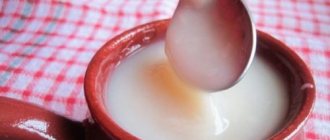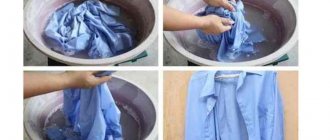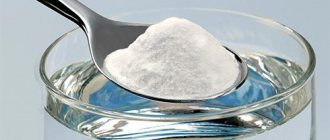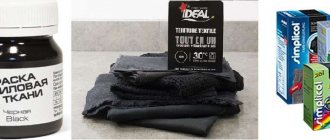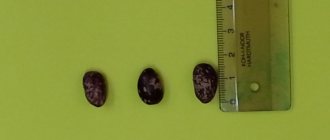Starched linen wrinkles less and does not get dirty as quickly.
Nowadays, it is rare that a housewife bothers herself with starching her bed linen after washing. This procedure, considered mandatory in the past, has quietly lost its relevance.
This happened partly due to the emergence of universal means for washing and rinsing things, partly due to the use of smart household appliances that efficiently perform labor-intensive work without human intervention.
However, sleeping on starched linen that smells fresh and is squeaky clean is much more pleasant. And these are not all the benefits that such treatment of bedding provides. Let's remember how to starch laundry, why to do it and what products are needed for the procedure.
How can you starch fabric?
In hypermarkets you can buy special spray, solutions and powders for use in an automatic washing machine.
These tools are very convenient to use. The aerosol can must be shaken and sprayed onto the fabric, ironed with a hot iron. Large items, such as sheets and duvet covers, are best starched in the washing machine using a special powder mixture or solution.
How to properly starch fabric in a washing machine - you can learn about this by reading the instructions for the product.
Any housewife knows that fabric can be starched with starch. It’s better to do this with potato (it’s easier to buy), but you can use corn or rice. Starch can be used to starch any item, be it a sheet or a napkin.
There are other methods of starching that are suitable only for openwork decor. These include starching with sugar, gelatin and PVA glue.
What does starching do?
So, why starch fabric at all? At first glance, starched items only hold their shape better and, in some cases, this is an important plus. But that is not all!
The fact is that the starch solution forms a thin film on the surface of the material. This film serves as a kind of barrier between the fabric and the environment; all dust and dirt settle on it. Therefore, it will be easier to wash starched parts: dirt will easily be washed away along with the starch! This property of starched items has one consequence: the film on the fabric also prevents the passage of moisture and air, which means you should not starch underwear and bed linen.
In addition, it is not recommended to starch dark fabrics and synthetics.
Traditional way at home
Before you start starching, you need to familiarize yourself with the peculiarities of carrying out the procedure at home.
Kinds
There are three main types of clothing processing.
Soft
It is recommended to use this method if you need to process dresses made from thin materials. In this case, use a small amount of starch powder. It is enough to add one and a half tablespoons of the substance to a liter of water. Soft starching is suitable for products made from knitted fabrics.
Medium hardness
The average intensity of starching is not suitable for every item. Experts advise using this method when working with napkins, tablecloths and bed linen. You can also start processing skirts, sweaters and durable shirts. This technique is completely unsuitable for evening dresses, as it can damage the fabric material.
Hard
The brutal method is not used very often, because it is not suitable for all things. People who regularly starch are advised to use it when processing shirt cuffs or collars. Sometimes skirts and dresses made of durable fabric are processed using this method. Hard starching clothes is necessary to give them shape.
Preparation of the solution
To prepare your own solution for starching things, you need to:
- add 90 grams of starch to 500 milliliters of water;
- boil 400 milliliters of liquid and add it to the starch mixture;
- the resulting solution is thoroughly stirred and re-boiled on the stove for half an hour;
- The liquid is poured into a separate bowl and left to cool.
Recipe improvement options
There are four ways to improve the recipe for creating a starch mixture.
For whiteness
Some housewives starch evening dresses to make them whiter. In this case, the solution will have to be prepared according to the standard recipe. However, a little blue is added to the resulting mixture, which helps get rid of dirt and stains on the fabric surface.
For shine
A special recipe for shine will help give things freshness and make them more attractive. To prepare the paste, starch is mixed with talc and water. After this, a napkin is dipped into a container with liquid, through which the woman’s dress will be ironed. The shine remaining on the fabric after ironing will not disappear even after washing.
For easy ironing
Sometimes starching is done so that dresses wrinkle less and are ironed better. To remove bruises, starch liquids are used, during the production of which not only water, but also milk was added. No more than 60-80 milliliters of milk dissolves in a liter of water.
To save color
It is no secret that colored items are washed over time, and their color becomes less bright. To make bright dresses always look beautiful, you need to use a special product.
Processing things
Treating clothes with starch solutions is quite simple. To do this, dresses are placed on an ironing board or any other flat surface. Then a cloth napkin is moistened in the liquid and the surface of the dress is treated with it.
General rules for starching
First of all, you should remember that it is not recommended to starch things made from synthetic fibers, as well as silk. Products made from flax, cotton, satin, calico, cambric or chintz are subject to starch treatment. Linen becomes starchy only after washing and rinsing, that is, in a clean state.
There are three degrees of starch treatment of linen:
- delicate processing. First of all, bed linen is subject to this treatment. Typically, for delicate processing, the paste is prepared at the rate of 1 spoon of starch per 1 liter of water;
- soft processing. It is mainly used for underwear (blouses, shirts, blouses, T-shirts, dresses, etc.). Such things should be soft and pleasant to the touch, so the concentration of starch remains practically the same as with delicate processing;
- medium processing. This degree is suitable for tablecloths, napkins, lace or curtains. The proportion is approximately 2 tablespoons of starch per 1 liter of water;
- hard processing. Suitable for standing collars and petticoats. For this treatment, the solution is prepared at the rate of 1 spoon of borax and 70 grams of starch per 250 ml of warm water.
You can starch laundry using two methods: conventional (by hand at home) and in the washing machine.
Examples of using
The scope of application of a solution with starch can be varied. However, the procedure is more commonly used for the following items.
Bed sheets
Properly starched bed linen has an attractive appearance, does not wrinkle and is pleasant to the body. To starch laundry, you can add the solution directly into the washing machine during washing. For bedding, a medium consistency solution is used.
Tulle
Using a starch solution, you can refresh the curtains and give them the desired shape. For such purposes, a soft solution is prepared: 1 spoon per 1 liter of water, the curtains are rinsed for 5 minutes and ironed while damp.
Shirt
A starched shirt looks better on the wearer. To do this, use a solution of medium consistency; the washed shirt is placed in the solution and left for 15 minutes. After which it is wrung out of excess water, dried and ironed damp.
Tablecloth
For tablecloths, you must use a concentrated solution. The fabric is placed in liquid and left for 2 hours, after which it is dried and ironed. The fabric treated with the solution takes the required shape and looks elegant.
What is it for?
The meaning of the starching procedure is to immerse or rinse things with a starch solution. Absorbed into fabric fibers, starch forms a very thin protective film on the surface of products.
Fabric impregnated with starch paste becomes more durable, less susceptible to wrinkles, and retains its shape well. The protective layer also prevents clothing from getting dirty. If you periodically starch your laundry, you will notice that it does not get dirty as much. It is impossible not to note the improvement in the quality of washing: the starch film, in contact with soapy water, instantly dissolves, and at the same time all contaminants disappear.
If you starch white linen, you can achieve the perfect whitening effect. Also a pleasant addition will be the exceptional freshness of things and a pleasant aroma.
How to starch things correctly
Before proceeding directly to the main process, the textiles must be washed and rinsed well. The procedure for starching looks like this:
- Place a clean, damp or dry cloth in a warm solution with a certain concentration of starch.
- Allow the mixture to spread between all folds of the fabric.
- The length of time the fabric remains in the basin is determined by its density and the desired effect. The denser the material and the more rigid you want to make it, the longer you need to hold it. For silk items, 1-2 minutes is enough. You can hold the cotton fabric longer - 10-15 minutes.
- Take the item out of the basin, gently wring it out and put it on the line to dry, straightening it out well. When the fabric is dry but slightly damp, iron it with a warm iron.
Any type of starch is suitable for preparing a starch solution. Most housewives prefer potato, because it is easy to find and costs nothing.
The concentration of the solution is determined by your goals, as well as the type of fabric from which the items are made. There are the following methods: soft, semi-hard, hard. Each method has its own characteristics and is suitable for certain purposes, which I will discuss below.
The soft way
This method is used to give things elasticity without making the material hard to the touch. This method is excellent for products made of silk fabric, cotton fabric, chiffon, cambric. As a rule, bed linen, dresses, blouses, shirts, tulle, etc. are subjected to soft processing.
How to prepare soft starch solution:
- You will need 1 teaspoon of starch per liter of water.
- First, mix it with 200 ml of cold water. Stir well so that there are no lumps in the mixture.
- Boil the remaining 800 ml of water.
- Pour the previously prepared cold mixture into boiling water, stirring constantly.
- Turn off the heat and let the solution cool.
As a result, you should get a homogeneous liquid, a little like jelly. I did something similar when I “composed” finger paints for my son.
Have any lumps formed? Filter the solution through cheesecloth or a sieve. Don’t be too lazy to do this, as these lumps may not have the best effect on the final result of starching.
Semi-rigid method
Do you want to quickly tidy up furniture covers, curtains, tablecloths, napkins or lace on clothes? Feel free to use semi-hard treatment.
The mixture required for this procedure is prepared in the same way as a soft solution. The only difference here is that you will need 1 tablespoon of starch per 1 liter of water. Increasing the concentration will also make the mixture a little thicker. However, if it turns out to be too thick, it can be diluted with a small amount of warm water.
Hard
What things are usually subject to harsh processing? These are all kinds of decorative textile items, petticoats, tutus, knitted boots, cuffs, collars, knitted bags, etc. That is, those objects that need to be processed in such a way that they stand and do not lose their shape.
To prepare the mixture necessary for hard processing, you can use our previous recipes. But in this case, we will increase the concentration of starch to 2-5 tablespoons per 1 liter of water.
You can prepare a slightly different solution for these purposes:
- Dilute 50 g of starch in 200 ml of cold water.
- Next, dissolve 1 teaspoon of borax (aka sodium boric salt) in 200 ml of hot water. Wait for the liquid to cool and proceed to the next step.
- Boil 600 ml of water. While constantly stirring slowly, pour in the starch solution.
- Now add the borax solution to the resulting mixture.
- The solution can be used in just 2 hours, but in the meantime you have time to prepare clothes or do other household chores.
What type of starch should I use?
For starching, as the name implies, starch is used. But which one? The modern product market offers the following types of starch:
- Potato starch,
- Corn starch,
- Wheat starch,
- Rice starch.
The different types of starches look almost identical. Yes, and they differ greatly only for cooking, but when starching, their properties are very similar. The only difference is the degree of density of the substance obtained during dilution. Of the above types, it is potato starch that performs best, which, however, is one of the most popular and widespread types of starch, which is sold everywhere in our stores.
How to prepare the solution?
You can treat with starch not only the entire item, but also its individual parts - collars, cuffs, skirt or petticoat. Potato, corn and rice starch mixed with plain water is suitable for this.
Starch treatment is carried out after mandatory washing of the product and removing stains. According to the degree of hardness, the solution can be:
- soft – for thin, delicate fabrics;
- medium - for cotton, linen products, mainly for bed linen;
- rigid - to firmly maintain the shape of a dress, petticoat, tutu, cuffs.
Depending on the fabric and the desired degree of hardness, the starch solution is diluted. How to starch a dress will be discussed in detailed step-by-step instructions.
- Starch in the required quantity is poured into a container and diluted with cold water in an amount of 150-200 milliliters.
- The mixture is thoroughly mixed to eliminate lumps.
- Boil the remaining water and pour the starch solution into it.
- When stirring, the composition becomes homogeneous, after which the container is removed from the heat.
- After cooling, lower the item into the solution at room temperature for 5-10 minutes, making sure that the liquid gets into and saturates all the folds.
- The product is taken out and hung to dry separately from other things, after making sure that there are no creases or folds.
The updated dress needs ironing. Individual details of outfits are most often ironed without waiting for them to dry.
Now about the starch solution, which is prepared based on the type of fabric and the required rigidity that needs to be given to the product.
- A soft solution is prepared from 1 teaspoon of starch and 1 liter of water;
- For medium hardness you need 1 tablespoon of starch per 1 liter of water;
- A hard concentrate is obtained from 2 tablespoons of powder per liter of water. You can also add a little boric salt, blue, or turpentine, which gives the products shine and attractive effect.
For items made of chiffon, knitwear, cambric, chintz, muslin, a soft concentration of the mixture is suitable. You can starch a dress made of tulle, silk, lace or linen or cotton bed linen with a medium-hard solution. For knitted items, collars and cuffs, and petticoats, a hard starch solution is needed.
Attention: 1 teaspoon of salt added to the mixture of starch and water will eliminate the problem of the iron sticking to the fabric. In addition, salt will give a white outfit a slight shine and shine.
Recommendations for drying and ironing
To ensure that the final result of your efforts is pleasing to the eye, it is important to properly dry and iron starched items. Basic recommendations:
- Products must be dried in a ventilated area. It is advisable not to place them in direct sunlight, on heating devices or in frost.
- It is better to dry shirts, dresses and bed linen in an upright position on hangers and lines, respectively. They should not be pressed too hard to prevent creases from forming.
- Openwork napkins and lace should be dried horizontally on a terry towel. They need to be well straightened, aligning all the elements, and pin the edges with pins. You can also use hoops and wooden frames.
- It is advisable to iron the products in a slightly damp state with a warm iron without steam, placing a thin cotton cloth or gauze on top to avoid sticking. Items with embroidery must be ironed from the inside out. Dried clothes are almost impossible to iron.
Starching textiles is an affordable way to make them look fresher and more attractive. It is important to choose the correct solution concentration depending on the type of fabric, level the wet product and iron it in time before it is completely dry. Dark wardrobe items, synthetics and underwear should not be subjected to this treatment. If you don’t like the effect of starching, just wash the item.
Why starch things at all?
Clothes, bedding or lace are immersed in water in which starch has previously been diluted. When the fabric dries, an invisible film remains on its surface, imparting rigidity. Clothes look better and don't wrinkle. In addition, starched items are much easier to wash. After all, the film prevents dirt from being absorbed into the fibers of the fabric.
There is also a drawback. Before you starch things at home, you should think about how they will be used. The fact is that starch does not allow air to pass through. Therefore, summer wardrobe items cannot be completely processed. You can stiffen the collar or cuffs. Bed linen can be fully starched.
Every housewife should know how to starch things correctly. The main thing is to be able to properly prepare the solution, which consists of only two ingredients: water and powder. There are many varieties of starch available on the market. Most often you can find a powder that is extracted from potatoes, rice or corn. Starch from different products has some differences. They are essential for cooks and cooks. But for those who don’t know how to starch a thing, it doesn’t matter which powder to choose.
Most housewives most often use potato starch. This powder has a slight bluish tint and thickens quickly when diluted with water. Cornstarch can also be used. But it thickens much worse, which means it imparts less rigidity to things.
Before starching an item, it should be washed thoroughly. It is not advisable to use fabric softeners. They will only repel starch. In order for the solution to saturate the material, you should dip a dry or slightly damp item into it.
This option is suitable for light dresses, underwear and snow-white blouses. These things should not be too hard, otherwise they will simply be uncomfortable to use. Before starching an item, you need to prepare a weak solution. One teaspoon of powder will be enough for a liter of water. The solution can be prepared using cold water. The powder is stirred until all lumps disappear. Next, a small portion of the water is heated to boiling. Start pouring the starch solution into the bowl with the hot liquid, stirring constantly.
You must wait until the mixture cools down. As soon as it reaches room temperature, you can lower the item into it. The result should be a cloudy liquid, the density of which will be slightly greater than that of plain water. The clothes are rinsed in the resulting liquid or soaked for several minutes. This time will be enough for all the fibers to be well saturated with starch. There is no need to squeeze the clothes too hard. Starch gives fabric rigidity. In order to iron it out, you will have to put in more effort.
This method is used to stiffen men's shirts, tablecloths, furniture covers, and lace. How to starch things correctly? You'll have to use a little more powder. Two teaspoons of starch per liter of water will be enough. The method for preparing the mixture is the same. First, the powder is diluted with cold water, and then hot liquid is added.
The mixture is considered correct if it turns out translucent and has the consistency of liquid sour cream. Dry or slightly damp items are immersed in the solution for five minutes. It is better not to wring out clothes. To avoid unsightly creases, you need to let the solution drain on its own.
This option is most often used for various decorative elements, as well as petticoats of wedding dresses. This treatment option is used least often for cuffs and collars. How to starch something with potato starch? Additionally, you will have to use borax. A teaspoon of this substance is diluted in a glass of hot boiled water. Two tablespoons of starch are diluted to a homogeneous consistency in a liter of cold water. Additionally, heat another liter of water to a boil and pour it into the starch solution. Lastly, borax is added to the mixture. All ingredients are mixed and left for two hours.
The hard starch solution should have a thick consistency. If it is necessary to stiffen large items, the amount of ingredients increases proportionally. There should be as much liquid as necessary to completely cover the fan. The fabric is soaked in the solution for 20-30 minutes. Next, the item is taken out and the mixture is allowed to drain.
We carry out the processing procedure
Don’t worry that preparing the solution itself, then the processing procedure, are difficult and time-consuming.
You need to remember what benefits this will give, and after doing everything necessary once or twice and getting acquainted with the result, no one will want to give it up.
Consists of several stages:
- Take a large container to fit the laundry;
- Pour the solution, it should be warm;
- Load all accessories;
- Leave for 20 minutes;
- If the container allows and there is a desire, you can not soak, but rinse things thoroughly;
- Squeeze, but you shouldn’t overdo it, as the fabric didn’t have any strong creases;
- Shake well and hang to dry.
There is no need to wait until the fabric is completely dry; it is better to iron the bedding slightly damp.
During ironing, the iron temperature should be medium or low. High temperature will ensure adhesion during ironing.
Over-dried bedding is much more difficult to iron. You can simplify this moment with the help of water, which is sprinkled on the fabric!
How to starch large items: bed linen or curtains?
Starch helps bed linen not wrinkle and stay clean for a long time. To prevent sheets and duvet covers from being too hard, they should be treated with a weak solution prepared in a proportion of 1 tsp. for 1 liter of water.
It is necessary to calculate how much liquid is needed for soaking, based on this, prepare a starch paste. For 10 liters you will need 10 tsp. starch, stir it in a glass of water and pour this mixture into boiling water. When it cools down, soak the laundry in it for 10 minutes. When drying, sheets and duvet covers must be straightened out well, otherwise they will be difficult to iron. It is easy to starch curtains in the same proportions. They are hung on windows wet so that the fabric straightens under its own weight.
